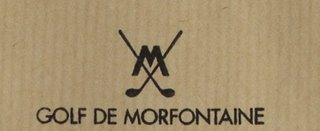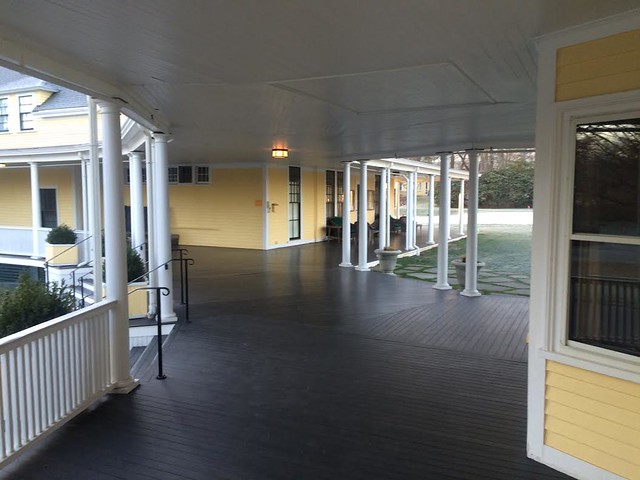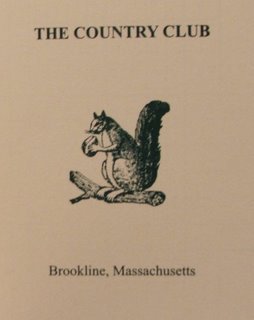
A hunt club? Isn't this a quest to play the world's top golf courses? It is indeed. However, one of them happens to also be a hunt club. Early golf clubs in this country were often inter-twined with other leisure pastimes. Merion was originally both a golf course and a cricket club. Myopia was founded for both equine pastimes and for golf. Another famous early U.S. course with a non-golf history is the C. B. Macdonald-designed gem on Long Island, Piping Rock, with its polo field, now converted to one of the largest driving ranges in the world. Although not on the world ranked top 100 list which I am playing, Myopia Hunt Club is on the top 100 U.S. list (ranked #69), and is worthy of a far higher ranking on that list, in my view. I first got the chance to play this below-the-radar course in 1997 and jumped at the opportunity. Actually, I pestered the member until he cracked and invited me. The course, located 30 minutes north of Boston, is not widely known. It has hosted the U.S. Open four times (1898, 1901, 1905 and 1908). Hosting the 1898 tournament puts Myopia into a small fraternity of only five elite courses that hosted a U.S. Open in the nineteenth century.
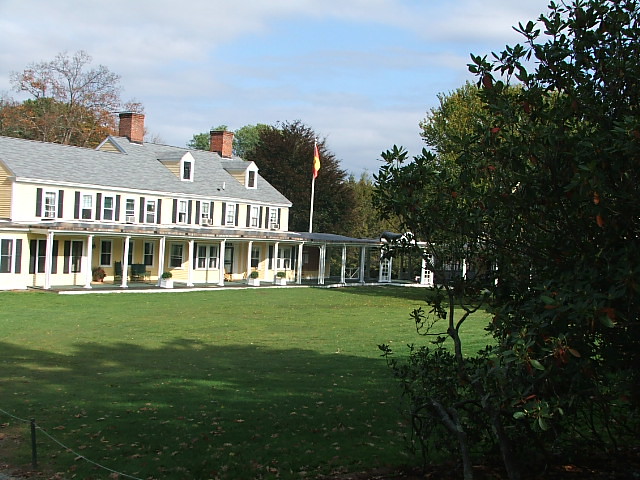
The elegant 18th century farmhouse, now the clubhouse at Myopia Hunt Club just drips "New England"
The course was designed by Herbert Leeds, who had no prior experience in course design. He redesigned and expanded the original course at Myopia, which was laid out by the club's Master of the Hounds! Leeds work here adds weight to the argument that many of the world's great courses were the result of 'amateur' architects on their first attempt. In this regard, Myopia is like Hugh Wilson's work at Merion and Henry Fownes's at Oakmont. They are iconoclastic, unique, and world-class courses developed by a non-professional who was passionate about golf. The other beauty of Myopia, as pointed out by Cornish & Whitten in
The Architects of Golf, is that the course exists today virtually as it was laid out. It has only been restored from time-to-time to keep it in its original state, but it has not been redesigned. They rightfully call it a landmark course.
I have always been a believer that first impressions are often correct. My first impression of Myopia Hunt Club was quite favorable. My readers know that I like old, traditional golf courses. This New England classic is a real gem, reminiscent of courses in England. Driving down the tree-covered road into the club you immediately see horses gently striding behind a post-and-rail fence and you pass over a humped-backed bridge, all of which combine to create a feeling of joy. A polo field is located to your right as you drive into the cloistered environment.
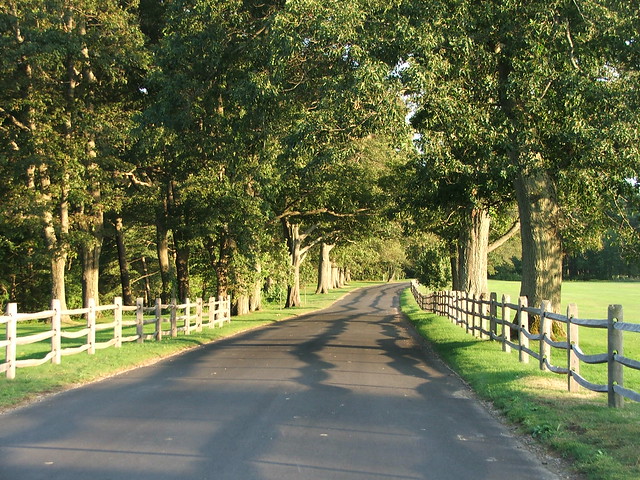
The regal entry drive at Myopia Hunt Club
The Golf Course
Scorecards, like looks, can be deceiving. Myopia plays 6,555 yards from the tips, therefore, it's probably not that hard, right? Wrong. Leeds's strategic use of cross-bunkering and the difficulty of the greens means that Myopia has stood the test of time and is still challenging today. The USGA Course rating is a stiff 72.7/138. Consider that among the five highest total scores in the history of the US Open four of them were scored at Myopia. Even if you take into account the difference in equipment, the winners averaged a score of 80 at Myopia, while during the same era the winning scores at Opens held at Baltusrol, Chicago Golf Club, and The Country Club were 10-20 strokes lower!
The golf course is situated behind the clubhouse and locker room buildings, a short walk up a hill. Among one of its many charming quirks, the red tees at Myopia are the back tees. The opening hole is a very short (276 yard) uphill par four where you hit a blind drive and it is a relatively easy hole, although the tilted green is trickier than it looks. If the drive in and the general environment of the club didn't tip you off that this is a noteworthy club, the greatness of Myopia as a golf course is confirmed early in the round as you stand on the second tee and look across the expanse stretching below you.
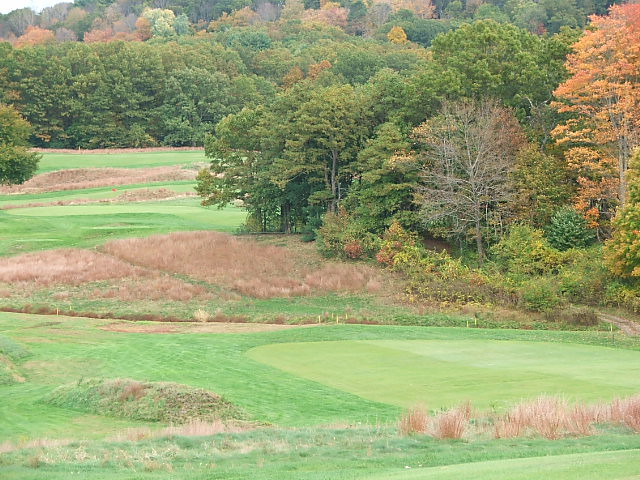 Myopia's enchanting second hole is set at the top of a hill and gives a sweeping view of the heavenly property the course is built on
Myopia's enchanting second hole is set at the top of a hill and gives a sweeping view of the heavenly property the course is built on
The 488-yard par five second hole is an absolutely beautiful hole where you hit your tee shot from an elevated tee down into a valley (shades of Sunningdale's 10th hole) to a fairway that is deceptively hard to hit because the tee box points you to the fescue right of the fairway. The third hole is a testing 253-yard par three with a small green. It has one of Leeds's signature slashing cross bunkers running across the fairway to the hole. As such, Myopia presents challenge and variety not only early in the round, but as you continue around the course it sustains this for all eighteen holes.
The course meanders around what I found to be surprisingly hilly terrain in this part of Massachusetts. It is a true parkland course in the forest. Look at the picture below from the fifth hole, which is typical of the course, and if I didn't tell you it was Myopia, you could quite possibly mistake it for the heathlands surrounding London. The 5th hole, a 417-yard par four that looks tame, but due to the angle the fairway is situated at and the gentle rolling of the terrain, it is anything but, and plays as the number two stroke index hole.
Myopia #5 - Shades of Sunningdale or Walton Heath?
I really liked the sixth hole, a 255-yard par four which demands accuracy on your tee shot (water right and O.B. left over a stone wall), and precision on your approach shot (a tabletop green), as well as a deft touch with the putter.
The 9th hole, pictured below, is a brilliant par three with a postage stamp green. The green is only nine yards wide and surrounded by seven steep bunkers. One of the defining characteristics of Myopia are the deep bunkers, which are, as you can see, reminiscent of those found in the British Isles. This is unmistakably an all-world par three.
As you play Myopia you will occasionally see bridle paths crossing or paralleling various holes. Rather than taking away from the course, they add to its distinctiveness. One of the local rules at Myopia is that you can take a free drop if your ball lands on a bridle path. I hit onto a path once during my round but decided to hit from the path instead of dropping, which plays like a sand shot.
Myopia #9 - A world-class par three postage stamp hole
The back nine begins with a bang. The tenth hole is a par-4, 404-yard Alps prototype hole. What makes the hole especially challenging is the blind tee shot. Since you are hitting over the rise of a big hill, you don't fully appreciate that any ball to the right of center feeds down into a jail at the bottom of the hill. The hole also slopes from left to right from tee to green. President Taft, who played his summer golf at Myopia, also had trouble with the deep bunker located in the fairway as you approach the 10th green. The hefty commander-in-chief couldn't climb out of the bunker so the secret service had to bring in a couple of horses and tie a rope around the portly golfer to assist in extricating him.
The 11th hole, Leeds's rendition of a Road Hole, is a short par four (349 yards) that has a menacing cross-bunker jutting across the fairway at a rude angle. Bobby Jones played the course while attending Harvard Law School and apparently had trouble getting across this well placed hazard on a regular basis. One of the reasons Myopia is such a deceptively difficult course can be seen on the eleventh. All the fairways have a tilt or slope to them, which feeds balls into either the rough or a bunker. The course has stood the test of time because Leeds understood better than almost any architect ever has that using a hillside as a hazard (without overdoing it) is far more effective than it looks. Similarly, like at Baltusrol, the greens are challenging because they look relatively flat, however, since the entire property slopes off a big hill, there is a dominant break down toward the club entrance that is difficult to discern.

The maddening par-4 thirteenth green at the top of a large hill. The putting surface is onerous.
The thirteenth hole, pictured below from behind the green, is an uphill par four (358 yards on the card) where your second shot plays about three additional clubs longer than the scorecard indicates due to the severity of the hill. This hole parallels the second hole, so you are playing up the hill that you hit from the elevated tee from earlier in your round. The thirteenth green is probably the most extreme example on the course, but is indicative of the greens at Myopia. They are tilted, canted, pitched, banked, slanted, and angled, but don't appear to be half as severe as they actually are. It is always advisable to play more break than you think, but even when you do, more likely than not haven't played enough. It is a true challenge in the positive meaning of the word, a real test of your ability to pick the correct line and speed on these perfectly conditioned and fast greens.

Green #13 seen from the rear
The 16th hole is a challenging 192-yard downhill par three that plays back toward the clubhouse, and like many holes at Myopia provides a stunning vista as can be seen from the picture taken from this elevated tee, below. Despite my bad manners I have been invited back to Myopia a half dozen times and I am always taken aback about how harmonious the entire environment is, it personifies Old World New England. The club has undertaken a tree removal program over the last several years, clearing out hundreds of trees to open up the vistas more and to have more wind impacting the golf shots. The changes are noticeable and well advised, they did a nice job with them.
A strong case can be made that the collection of par three holes at Myopia are as good and as challenging as any in the game of golf. Even though there are only three of them, in my view, they rank up there with Pine Valley and Woodhall Spa in terms of challenge presented to the golfer. Consider the 3rd hole. How many par threes have a fairway on them so you can lay up because you can't reach (or hold) the green? Not many; the par three 16th at Cypress Point being a notable exception. The 240+ yard hole also plays slightly uphill. Modern architects like to have balance on golf holes: if it's challenging from tee to green they will typically cut you some slack when you're on the putting surface. Leeds design philosophy is of the take no prisoners camp, thus, the 3rd green is a challenging surface. My guess is that modern architects also wouldn't design a green as narrow as the ninth today for fear of the course owner or members complaining about its severity. Did the designer of the Postage Stamp hole at Royal Troon fret that it would be too severe? Apparently not, and Myopia's ninth follows the mold, with harsh fescue and deep trench bunkers penalizing misses. Finally, the 16th, like many at Myopia, doesn't appear that hard on paper, after all, it's a downhill par three of roughly 180 yards with a relatively large green, and you get a great preview of the green before you tee off since it is situated next to the first tee and you can examine its contours and peek at the pin position. Alas, you don't get to play the hole on paper, but in the real world, with all that mother nature brings with her. The complication for the hopeful duffer who has just put his or her ball on the tee is that they can barely see any of the putting surface; instead, the vista is a sea of fescue blowing in the wind, and because of where the green is situated, with the clubhouse in the background, the green's distance from the tee becomes wickedly deceptive, and you see only a tiny sliver of it. Leeds was three for three on the threes. Brilliant.
The 17th tee is right outside the pro-shop door and has an old stone wall down its entire left side that plays out of bounds. Holes 17 (a 394-yard par four) and 18 seem to be set-off from the rest of course and look like they will be anti-climactic, but in fact provide for the perfect finish since they are cut artfully into a tumbling hillside. The routing at Myopia is perfectly suited to the terrain and in my view is one of the best in the world of golf.
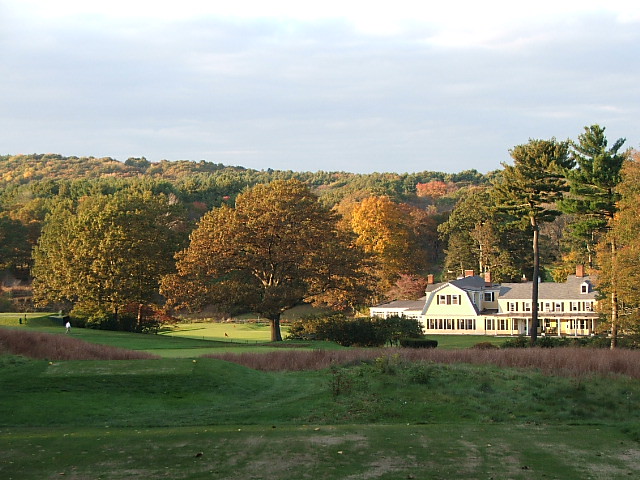
The Myopia Hunt Club clubhouse as seen from the 16th tee
The eighteenth is one of the best finishing holes in all of golf. It is 404 yards, a dogleg right and your tee shot is semi-blind. You must land on the left side of the fairway to have a clean shot at the green. This is harder than it sounds given the slope of the terrain and the hill. If you are on the right-hand side a hill blocks your view of the green. In front of the green are two massive and deep bunkers. Adding to the beauty of the hole are the horses strutting to your left as you approach the polo ground and the beautiful yellow farmhouse/clubhouse behind the green. The horses give the place a genteel and civilized ambiance.
Myopia Hunt Club as the whole package
I can't sing the virtues of Myopia enough. It strikes the appropriate balance between being intimate without being stuffy or pretentious. The membership seems perfectly suited to the historic club. As I suspected on my first visit and can now confirm after a half-dozen visits (including staying overnight in the clubhouse), the membership seems to have avoided the usual minority of blow-hards, half-wits, morons, simpletons, rummies and lackeys that make up a minority of any club. It is a rarity to combine a world-class course with a club that has the right mix of elements and intangibles. In all my journeys I have only seen this a handful of times: Myopia, Sunningdale, Maidstone, Royal Liverpool and San Francisco Golf Club. Each possesses an inveterate charm to complement their fabulous courses.
Many other clubs possess great golf courses but fall flat on the club or clubhouse environment. Some are trying too hard or are too uptight or snooty. Others have too many members you wouldn't enjoy associating with. These five pull it all off and are the real McCoy.
 The best bar at a golf club in the United States is at the Myopia Hunt Club
The best bar at a golf club in the United States is at the Myopia Hunt Club
The 19th hole at Myopia brings together a lot of what I like about old-style golf clubs and reveals many verities that I have found on my trips. Among the truths: 1) Length doesn't matter. Myopia is a sub 6,600 yard course from the tips, but is still a challenge. 2) Low-key, understated and intimate are better than big and flashy. In this regard, I like courses like Myopia and Sunningdale as opposed to big clubs like Wentworth, Congressional, or Medinah. 3) A variety of holes and shots make a better course. Nothing felt forced at Myopia, the course fits naturally into the terrain; there are a couple of short par fours, a 200+ yard par three and a 130-yard par three; some uphill holes, some downhill holes, and plenty of change in direction. 4) Old and quirky are under-appreciated. The bar at Myopia has no barman, the members sign chits for themselves and there are private lockers near the bar for members' liquor. The rooms in the clubhouse have low ceilings and a feel of antiquity. The old, original creaking floors will probably never be replaced, giving it a shabby-chic feel. There are antiquated enclosed telephone booths cut into the wall of the entry foyer where members used to discretely make phone calls without disturbing the ambiance. The locker room, housed in a separate building, is original and reminded me of another old original, Garden City on Long Island. A visit to Myopia is a truly memorable and distinctive day. The club is intensely private and there are less than 12,000 rounds played a year, which is about 50% less than at most clubs. If you can wangle an invitation, I suggest going at once.

The weather vane with fox motif adorns the clubhouse
Golfer Magazine described Myopia and its architect in 1898 thusly: "Leeds is as well known as a hunt club man as a golfer . . . The rolling inland gorse is admirable, the hazards natural, the distances good . . . It was only natural that the cry of Fore! should be heard mingling with the whistle of the quail and the music of the kennelled hounds. Experts have pronounced the links the best natural golf grounds in America." The description remains relevant today.
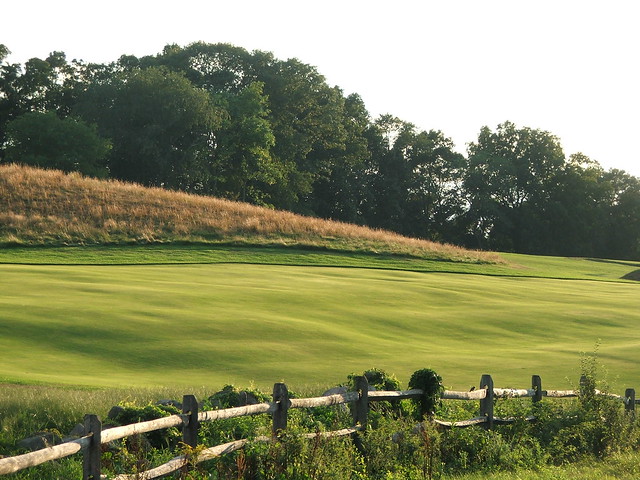
The sloping of the 18th fairway is best captured at dusk
It is not an exaggeration to say that the greens at Myopia are among the finest in the United States. Part of the reason I think Myopia is such as fabulous golf course is because Leeds kept tinkering with it and refining it over the years. As a member of the club he would sit in the bar and overhear golfers complaining about how easy or hard holes were and would make changes as such. The par-5 fifteenth hole ("Long") is a beautiful 529-yard hole that straddles the hill at the top of the property. When Leeds heard a couple of members complain that the hole was too easy he put in two very deep bunkers short of the green. Easy is not a word that pops into your head as you approach the green today. The course plays as a par 72 and even though it is short there are a couple of very testing par fours, notably #5 at 417 yards, #12 at 451 yards, and #18 at 400 yards. The course, however, truly excels with the short par fours. It is treacherous to compare any course to Merion, but it is my belief that the short par fours here are as good a collection, or better, than those at Merion, which are among the best in the world.
Speaking of Merion, where is the ball Bobby Jones used when he won the Grand Slam, finishing the U. S. Amateur at Merion? It's displayed in a very nonchalant manner tucked above a light in the bar at Myopia Hunt Club. To me it encapsulates everything about Myopia and reflects the ethos of the club perfectly. They have one of the treasures of the golf world on their hands but treat it in a very low key and respectful manner. Myopia is an anachronism in the world of golf to be cherished and preserved for posterity, which is exactly what their erudite membership is doing.
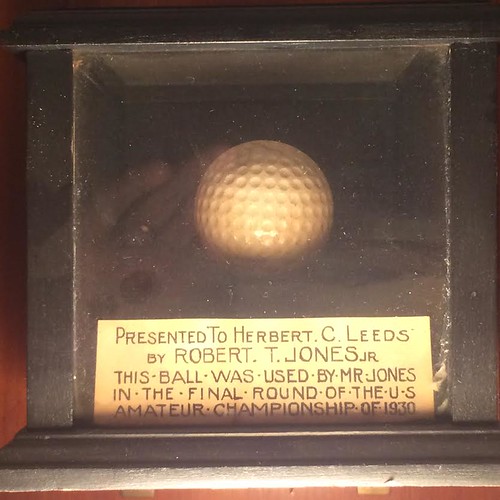
It is a lucky golfer who finds themselves walking on the boardwalk of the elegant Myopia clubhouse:
Myopia's blue blood roots run deep. The club first used the name Myopia Hunt Club in 1876. The august Republican Senator from Massachusetts, Henry Cabot Lodge, was a founding member of Myopia. The Harvard polo team still uses the fields at Myopia.
As I was playing at Myopia in the summer twilight recently there was a light breeze blowing and the ancient specimen trees were casting long shadows over the verdant fairways. It didn't take too much imagination to forget that I am an olive-skinned crank of Italian extraction from New Jersey, and I thought for a few moments that I was one of the original fair-haired Haa-vard boys who founded the club over a century ago, and that I was back in 1894 playing a leisurely round of golf. Myopia is timeless.
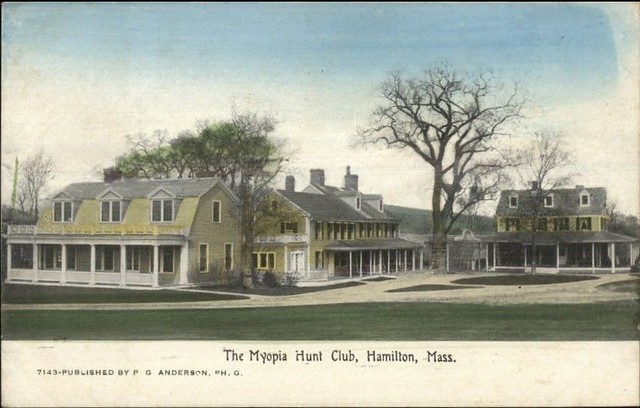
,
The scene at Myopia from a postcard produced in 1904. It could have been taken today.
Post Script - Not everyone agrees with my assessment of golf courses (I know, I find it shocking also). Even the skeptics among you must agree, however, that Myopia surely has the best logo in the world of golf. What could be better than a fox with a horn above his head?

